merovingian ties
beyond the 85 knots of Fink and Mao
Most of you have not noticed, I presume, because when the ↑character ‘Merovingian’ (Lambert Wilson) first appears in ‘↑Matrix Reloaded‘ (2003), your eyes were on ↑‘Persephone’ (Monica Bellucci) at his side. But, if you would have watched the Merovingian, and would have slid down your gaze from his face a bit—not quite as far as you practiced on Miss Bellucci—you would have noticed, that the man sports a decidedly strange looking knot on his necktie. Meanwhile there is a knot around which seems to resemble the one in the movie, and indeed is called the Merovingian [knot]—a tie-knot named after a character out of a cyberpunk movie of course triggered my interest, so I set out to clarify the matter. Contradicting information found on the Web made me review the movie and take some screen captures:
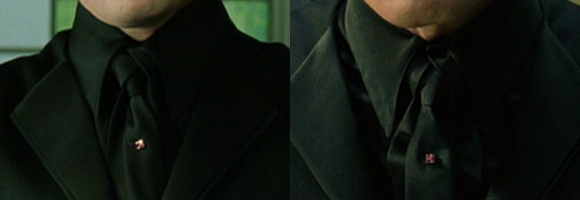
Both pics stem from ‘Matrix Reloaded’—the one to the left belongs to the scene in the restaurant where the Merovingian makes his first appearance, the one to the right from a scene a bit later, when, after Persephone’s betrayal, he storms into the Château. It is a bit hard to see, because—↵just like Fantomas—the Merovingian has it all in black: suit, shirt, and tie. But, with almost certainty, what he wears in ‘Matrix Reloaded,’ is a turned-around reverse Windsor. Allow me to explain. Looking closely you will discover two distinct features to be seen. First, the knot itself is covered by two diagonally overlapping strands of the tie. Second, the narrow end of the tie is in front of its wide-blade end—the other way around as usual. A regular Windsor-knot looks exactly like that, when viewed from ‘behind,’ like ‘out of the chest,’ that is. With one difference: When you look at a Windsor from behind, you also will see the centre seam of the tie. But that is not the case in the movie, hence the Merovingian’s tie must have been tied ‘in reverse.’
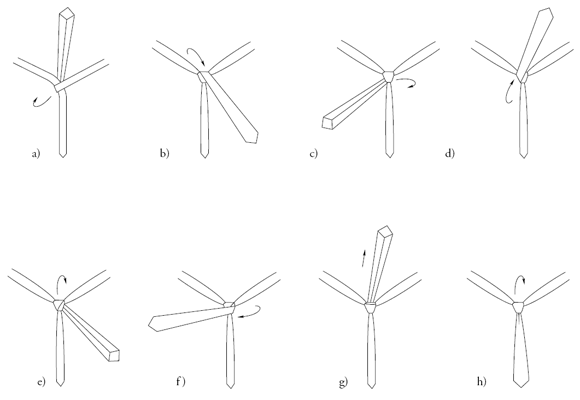
Regular tieing of the Windsor implies, that on starting out you hang the tie around your neck, wide blade to the right, and the seam-side towards your body. Reverse tieing means placing the tie with the seam away from your body. In order to achieve the knot seen in the screen caps, you have to reverse tie a Windsor, then take it off over the head, turn it around, and then pull it over the head again. Which is, to say the least, an inelegant, awkward procedure. As far as I remember Gianni Versace, at about the beginning of last century’s 90s, sold a tie accompanied with a tutorial of how to knot it the described way, so that the narrow end finally was in front. Back then a schoolmate of mine sported it at a club one night, and told me about it. I contacted him on this yesterday and he confirmed my memory, adding that it was a night-blue tie with a black Versace-Medusa, from wherever he is at the moment, checking his Blackberry—he became one of those ↵top-notch Nazgûl.
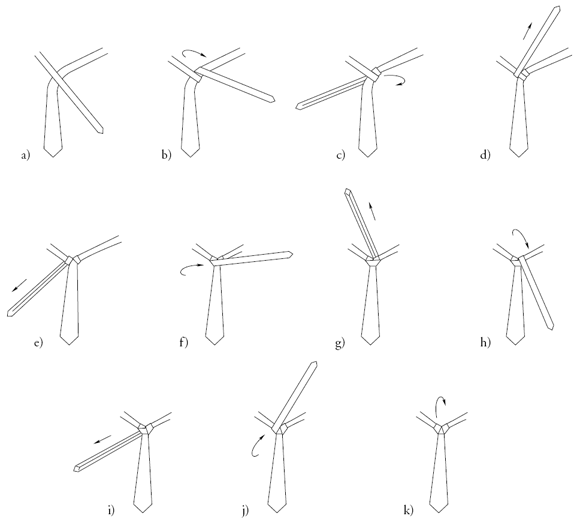
As mentioned above, meanwhile there is a knot around, which is referred to as ‘The Merovingian’—at least by ↑Lord Whimsy aka ↑Victor Allen Crawford III in his excellent ↑tie knot tutorials (scroll down to ‘No. 14: The Merovingian’ and download the stylishly designed .pdf), and ↑by the German Wikipedia. The origin of and story behind this knot is what I am after, although it is not the knot to be seen in ‘Reloaded.’
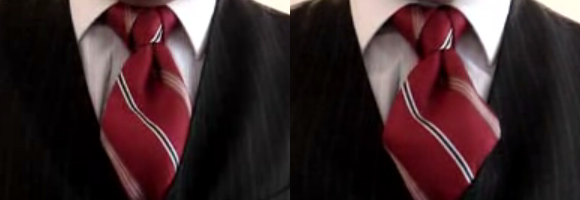
The movie was released on 15 May 2003—on 28 September 2003 edeity posted a .pdf-tutorial at zgeek.com, wherein he explained how to tie a knot he had envisioned. Years later New-York based banker and magician Henry ‘SimplyJustHen’ Hu got hold of the tutorial, but could at first not decrypt the four pictures, and hence thought the tutorial to be faulty. So he created his own solution, which he posted on 16 February 2007 at YouTube as a video tutorial—↑you can see a true master at work there. Alluring to the abbreviation of his first name, Henry christened it the ‘Hen-Tie,’ pulling of a pun on ‘Hentai’—in the West a common term referring to Japanese pornographic anime, manga, and computer games. ‘Hen’ alone in Japanese means ‘weird,’ so one can read ‘weird tie’ also.

At first SimplyJustHen was of the opinion that he had recreated the Merovingian’s tie knot, but on 31 March 2007 a video response on YouTube by frank77dk, called ↑‘Matrix Reloaded Tie,’ clarified the matter. Frank expertly explains and demonstrates how to do the knot, and even uses a special two coloured tie to get the tutorial clear as glass. His comment:
This is the tie worn by the Merovingian in the restaurant. I’ve been wearing this tie since I first saw it in the theatre, and have been calling it the Tarenta Knot, i’ve searched and searched for this tie everywhere and for what its called, and have found nothing. I don’t want to claim what isn’t mine, so if someone can come up with the legit name, i’ll use that, until then, it’s the Tarenta Knot to me ;)
About two months after the initial posting of SimplyJustHen’s video tutorial edeity and he agreed, that the knot in the video indeed was the one described in edeity’s .pdf tutorial—Hen immediately gave due credit and changed title and description of his video.
So, as it stands, what the German Wikipedia and Lord Whimsy refer to as the ‘Merovingian’ rightfully should be known as the ‘Edeity.’ The Merovingian himself never wore the tie-knot which now bears his name. Misnoming has quite a tradition, when it comes to tie-knots. The Duke of Windsor never wore the according knot. He tied his ties in a Four-in-Hand, but used unusually thick, upholstered ties, resulting in voluminous knots. Most probably the Windsor-knot was invented in an attempt to emulate the Duke’s hardware-supported style. There is also some confusion in respect to the ‘Pratt,’ which sometimes is referred to as the ‘Shelby.’ In fact this knot was invented by Jerry Pratt, a member of the US chamber of commerce. He regularly wore the knot for about twenty years, then showed it to his friend, television presenter Donald Shelby. Via the latter the knot became popularized, and the name at least partially stuck.
All right, we know now what kind of knot the Merovingian sported in ‘Reloaded’— a turned-around, reverse full Windsor. But what about the Edeity/Hen-Tie now known as the Merovingian? It is an inverse doubled up full Windsor. In this context ‘inverse’ means that the wide blade of the tie is ‘passive,’ meaning that it remains in position, while the narrow end is wound around it. In contrast all traditional tie-knots are bound by winding the broad end around the narrow end. More precise, using the Fink-Mao taxonomy, the Edeity/Hen-Tie/Merovingian is a knot of size: 11, symmetry: 1, balance: 3, and knotted status: yes—if I haven’t made a mistake anywhere. Its tieing sequence in (R, C, L) notation is:
Ri Co Ri Lo Ci Lo Ri Co Ri Lo Ci T
I have not added a super- or subscripted ‘inv’ for inverted, because the starting of the sequence with Ri already implies this, as regular tie-knots only can start with Lo or Li … What the hell I am talking about, you ask?
Well, in their book ‘The 85 ways to tie a tie,’ (Fink & Mao 2001) physicists ↑Thomas Fink and ↑Yong Mao
introduced a mathematical respresentation of tie knots and proved that, with a conventional necktie, there are exactly 85 possible ways to tie it. Of these, just over a dozen are sufficiently handsome or different from each other to be worn. These include the four traditional knots—the four-in-hand, the Nicky (a derivative of the Pratt knot), the half-Windsor and the Windsor—and a number of previously unknown knots.
In order to understand what I was babbling about above, Fink & Mao’s mathematical representation and taxonomy can be scrutinized in the two journal articles (Fink & Mao ↓1999, ↓2000), out of which the book grew, and on the ↑according part of Thomas Fink’s website. Best of course is, to buy their book—have not got it myself yet, but just ordered it. Hence, in the following I refer to Fink & Mao 2000.
The two men set out to settle the matter of tie-knots once and for all. But they based their work on some limiting axiomatic assumptions, thereby introducing a bit of cultural bias. My argument is, that the Edeity/Hen-Tie/Merovingian is not an element of traditional mainstream occidental culture, but an instance of the cybercultureal. For this context let us have a look on Fink & Mao’s assumptions. On the hardware side only ‘regular ties’ are taken into consideration. This is fine cyberculture-wise, too, because it has that ‘↵Origami air,’ creating the unusual out of basic, untampered-with material. Reverse knots are mentioned by them, but not explicitly those of the ‘Reloaded’ kind with the narrow end to the audience. I guess this is just too far away from societal consensus. Even my Nazgûl friend said, that he found the reverse Versace-thingie awfully cool at the end of the 1980s, but today smirks on it. Anyway, what the Merovingian wore is in Fink & Mao’s table, because it is just a regular tie-knot turned around. So, the reverse versions of regular tie-knots are covered by Fink & Mao, but the inverse knots are not. Here the two stick close to tradition, because it simply has been bequeathed, that when tieing a tie, you start out with the wide blade to the right and wind it around the narrow end. Principally the regular and inverse knots topologically would be the same, if the tie had no orientation, the ends would not be distinguishedly marked. But a regular tie is oriented, it has a wide and a narrow end, and Fink & Mao are perfectly aware of that: ‘The finite length of the tie, as well as aesthetic considerations, suggests an upper bound on knot size; we limit out exact results to h [smaller as or equal to] 9′ (Fink & Mao 2000: 113)—h being the number of half-winds, the ‘size’ of the knot. Herein lies the reason why they come to a result of 85 knots and not more. Size 9 is a sensible limit, not just because of the fact, that after a certain number of winds you simply have nothing more to wind around, but because of the wide blade becoming ever wider until the tip starts, the results begin to resemble a mangled football, but no more an acceptable tie-knot. Enter the Edeity/Hen-Tie/Merovingian: Its size 11 is possible, because the in this case active narrow end does not build up volume as fast. In terms of volume it is not larger than the Windsor (size 8), and hence still æsthetically acceptable. Furthermore, balance and symmetry are all right as well, and, like with traditional knot-ties, the wide blade is to the front, and the seam of the tie to the back. So, it is a new knot, doing justice to Fink & Mao’s—and occidental society’s—criteria, but going beyond their 85 specimen. Naturally, the visible inverted-V structure is a matter of debate, but, in the words of Fink & Mao, I leave that to the reader’s sartorial discretion. Me personally, I deem the Edeity/Hen-Tie/Merovingian to be beautiful—especially, of course, because of its background. Judge for yourself, here are some renditions of it by Yours Truly—I used ties of different lengths and materials, from polyacryl to pure silk:
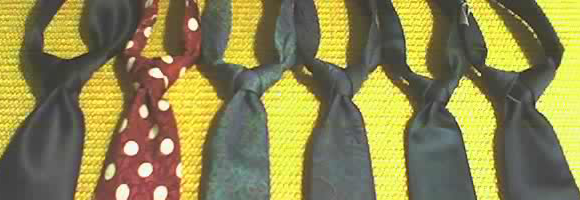
Now for why I take the new knot to be a cybercultureal tidbit. First of all it has been created in the attempts to reverse engineer the tie knot a character sported in a cyberpunk movie. True, reverse engineering is an important, but not an exclusive element of cyberculture—as we saw, the Windsor knot, too, was most probably invented by the attempt to recreate a particular style. Hence you could interprete this as a continuity in the tradition of the invention of tie knots, but the protagonists were not aware of this.
My second argument asks for the motivation, for the point in desiring to wear what the Merovingian wore. The principles of association, allusion, and referencing are core elements of cyberculture—for the outsiders mostly invisible, cryptical at best, for the insider and his peers demarcations of identity and ultimately communitas. Henry Hu himself said that the knot is ‘a nerd thing, a geek thing,’ … and that it ‘looks like alien penisses,’ to complete his hentai allusion. Wearing this offline ↑easter egg the knot is, already constitutes a ↑thrill to ‘the geek,’ a source of positive, identity-congruent sentiment. Like pouring your tea out of a Melitta original of the ↑Utah teapot would be.
My assuming, that the majority of the younger online generation loathes wearing ties, is an educated guess, but highly probable. There are multiple reservations against ties, but by means of its background, the Edeity/Hen-Tie/Merovingian got metaphorically so powerful, that it might serve as a blockbuster. Here is an excerpt from what cyberpunk-drenched computer game pundits and expert Second-Life content creators ↑Detect Surface and ↑acid Zenith—the latter cyber goth on- and offline—remarked, after I had told them about the knot:
[2008/06/04 14:46] acid Zenith: if i ever wear a tie,,, wich i doubt
[2008/06/04 14:46] acid Zenith: i will do that
[…]
[2008/06/04 14:49] Zephyrin Raymaker is tempted to write a blog entry on said knot
[2008/06/04 14:49] acid Zenith: do it
[2008/06/04 14:49] acid Zenith: ill know where to go when i need it then
[2008/06/04 14:49] You: …. so be it
[2008/06/04 14:49] acid Zenith: also its interesting
[2008/06/04 14:50] Zephyrin Raymaker starts in-depth research
[…]
[2008/06/04 18:14] Zephyrin Raymaker practices the Merovingian knot
[2008/06/04 18:15] Detect Surface: lol thats a good knot, I’ll wear that around the house
[2008/06/04 18:15] Detect Surface: and cook with it nakkid
[2008/06/04 18:15] You: Ha ha ha ha ha ha ha ha ha
[2008/06/04 18:15] acid Zenith: kinda makes me wish i had an office job, just so i could do that on the tie……. on second thoughts,,, lo fuck that
[…]
[2008/06/04 18:15] acid Zenith: can u imagine me in an office?
Third, by means of the work of Fink and Mao, tie knots have been popularized as topological artefacts—for those ‘in-the-know’ wearing a tie now means sporting a piece of mathematics around the neck.
Fourth, the last two newly invented knots before Fink & Mao, the Windsor and the Pratt, were popularized via the traditional mass medium of the newspaper. The Edeity/Hen-Tie/Merovingian was made known to the public via the Internet—first via edeity’s .pdf, then via SimplyJustHen’s video tutorial on YouTube. As of today the latter has been viewed approximately 87,000 times.
But that is not yet the end of the story, as the Merovingian, and Persephone!, both reappear in ‘↑Matrix Revolutions‘ (2003), the third part of the trilogy. This time he sports a red tie and shirt, matching Miss Bellucci’s … erh … tight dress and lipstick. He sports another knot, enormous and cylindrical, far from the elegance of the Edeity/Hen-Tie/Merovingian:
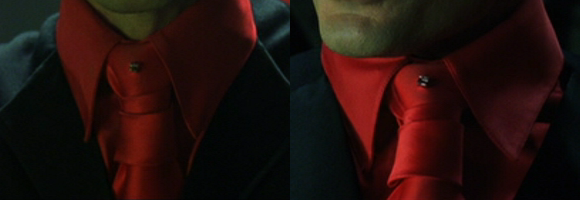
Although I do not know what it exactly is, it is nothing extraordinary, tech-wise. You can achieve a similar result by tieing any of the narrower regular knots, then winding the narrow end around it two times, and finally tug it away behind.
One last thing. The René-Magritte style cover of ‘The 85 ways’ features a surreal impossibility:

The tie’s European style stripes (pointing upwards to the wearer’s left shoulder) are oriented the same way on the tie’s blade and on the knot. This would only be possible when using a special tie, on which the orientation of the stripes reverses at a certain point. Frankly, I am tempted ↑to make such a tie, only to see if anyone notices the impossibility. That would be the only reason for me to, in the future, wear a tie and not tieing it the Edeity/Hen-Tie/Merovingian style.
Ah, yes, just to go full circle—pun not intended—here is Persephone:
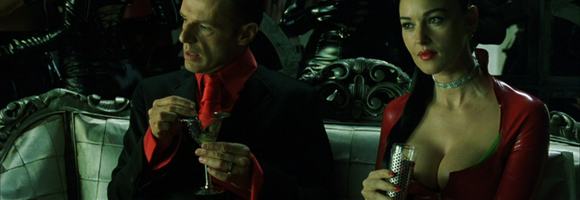


The knot as shown by Lambert Wilson doesn´t have to be done the inverted way. It can be done just very common …
The centre seam of Lambert Wilsons tie may be covered by the thin end …. the rest of the centre seam is covered by his jacket …. MAYBE…but I found another solution. I know: piccies or it didn´t happen. I´m gonna show! ;)